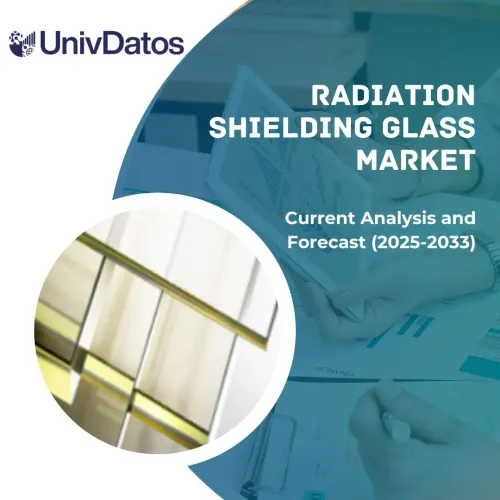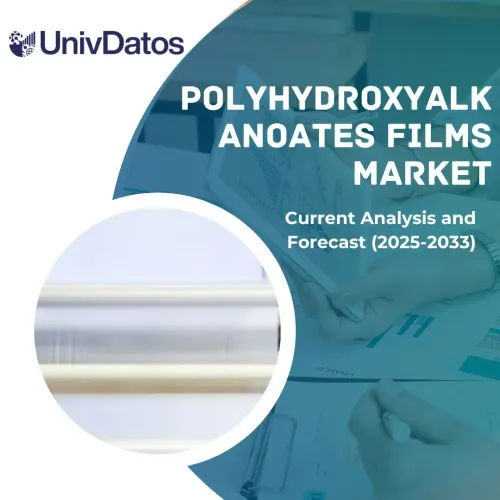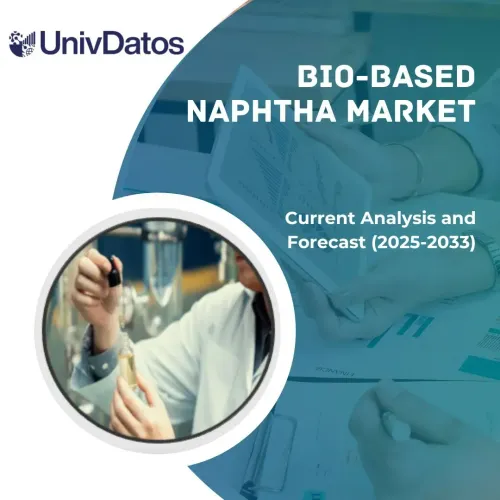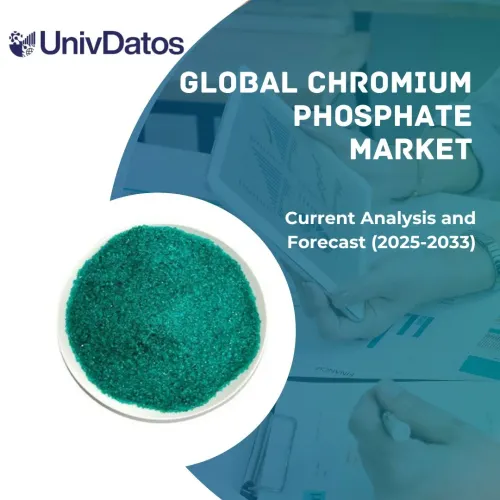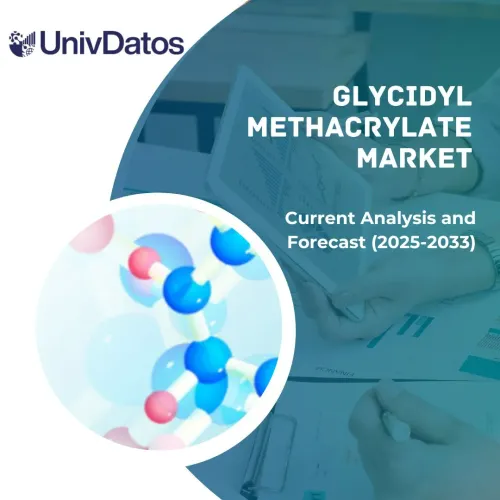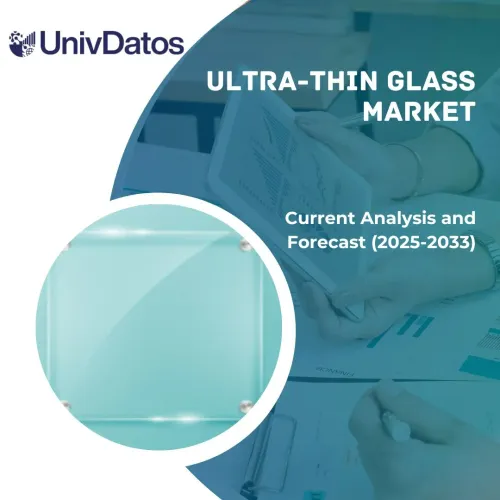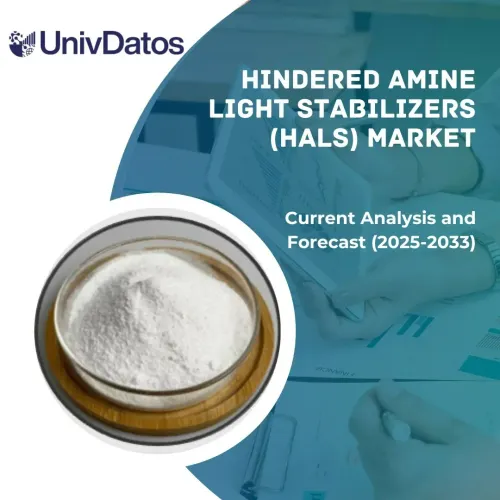- Home
- Chi siamo
- Settore
- Servizi
- Lettura
- Contattaci
Mercato dei reagenti di flottazione: analisi attuale e previsioni (2021-2027)
Importanza per tipo (flocculanti, raccoglitori, agenti schiumogeni, disperdenti e altri); Applicazione (trattamento delle acque e delle acque reflue, esplosivi e perforazioni, riciclaggio della carta, lavorazione industriale e altri) e regione/paese
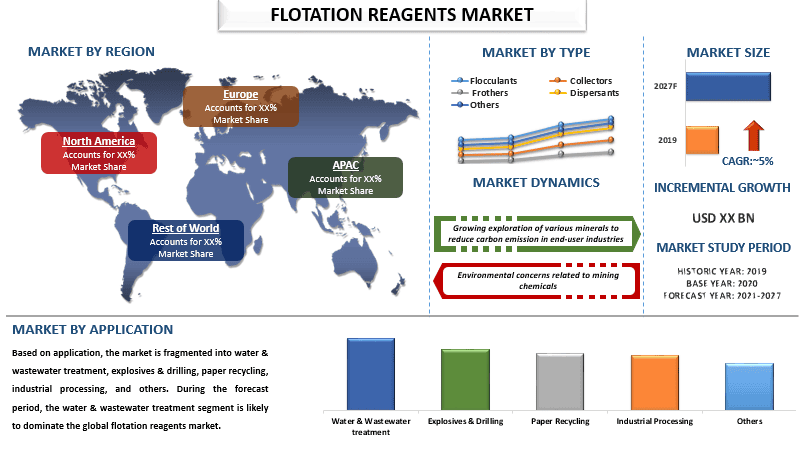
Si prevede che il mercato globale dei reagenti di flottazione registrerà un CAGR di circa il 5,27% durante il periodo di previsione (2021-2027).Poiché si prevede che il mercato assisterà a una ripresa dovuta alla rapida urbanizzazione, all'aumento del reddito disponibile e all'industrializzazione in tutto il mondo.Ad esempio, secondo la Commissione Europea e la rivista EU Research and Innovation, la domanda di veicoli elettrici e stoccaggio di energia aumenterà del 500% entro l'anno 2050 e ciò avrà un impatto positivo sulla crescita del mercato di minerali come grafite, litio e cobalto durante il periodo previsto.
I reagenti di flottazione si riferiscono all'agente utilizzato nel processo di flottazione dei minerali, che può regolare il comportamento di flottazione dei minerali ottenendo così un buon effetto di separazione dei minerali. Inoltre, l'utilizzo di reagenti di flottazione è il metodo più flessibile, efficace e conveniente per controllare il processo di flottazione. Poiché questo processo prevede l'aerazione dei minerali in acqua durante la presenza di reagenti di flottazione. I reagenti di flottazione includono promotori di pH, regolatori, agenti condizionanti, disperdenti di fanghi, solfidizzanti, attivatori e altri. Sono disponibili in varie forme come – solidi, pellet e liquidi. Alcuni reagenti di flottazione sono disponibili in vari tipi che sono – non ionici, cationici o anionici.
BASF SE, Cytec Solvay Group, Orica, Dow Chemical, Kao Corporation, Clariant AG, Evonik, Huntsman Corporation, Kemira Oyj e AkzoNobel. Diverse fusioni e acquisizioni insieme a partnership sono state intraprese da questi attori per sviluppare il mercato dei reagenti di flottazione.
Tuttavia, il Covid – 19 ha devastato l'economia globale a causa della quale molti settori hanno subito un crollo. Diversi paesi hanno imposto lockdown a livello nazionale come parte delle misure per limitare la diffusione del coronavirus. La crescita del mercato dei reagenti di flottazione è stata influenzata anche a causa della chiusura delle attività manifatturiere e del calo della domanda di servizi commerciali nel 2020. Inoltre, la volatilità dei prezzi dei reagenti durante la pandemia ha ulteriormente aggravato l'impatto sul mercato dei reagenti di flottazione. Poiché il COVID si è spostato verso l'energia pulita e le emissioni nette zero, il che dovrebbe incoraggiare la domanda di energie rinnovabili nei prossimi anni, riducendo al minimo la dipendenza da petrolio, gas e carbone, che guiderà il mercato dell'utilizzo di reagenti di flottazione durante il periodo previsto.
Approfondimenti presentati nel rapporto
“Tra i tipi, gli agenti schiumogeni detengono una quota significativa nel mercato”
In base al tipo, il mercato è frammentato in flocculanti, raccoglitori, agenti schiumogeni, disperdenti e altri. Durante il periodo di previsione, il segmento degli agenti schiumogeni dovrebbe dominare il mercato globale dei reagenti di flottazione. L'uso degli agenti schiumogeni è in aumento in quanto svolge molteplici ruoli come reagente di flottazione in diverse materie particellari. Inoltre, la flottazione a schiuma è un processo per separare selettivamente i materiali idrofobici dagli idrofili. Questo viene utilizzato nei settori della lavorazione dei minerali, del riciclaggio della carta e del trattamento delle acque reflue. Fattori come la crescente consapevolezza tra produttori e consumatori di riciclare la carta per raggiungere la sostenibilità stanno aumentando le dimensioni del mercato dei reagenti di flottazione.Ad esempio: secondo l'Environmental Protection Agency (EPA) 2018, nel 2018 sono state riciclate circa 46 milioni di tonnellate di carta e cartone per un tasso di riciclaggio del 68,2 percento, che era il più alto rispetto ad altri materiali nei rifiuti solidi urbani (RSU).
“Tra le applicazioni, il trattamento delle acque e delle acque reflue deterrà una quota significativa nel mercato”
In base all'applicazione, il mercato è frammentato in trattamento delle acque e delle acque reflue, esplosivi e perforazioni, riciclaggio della carta, lavorazione industriale e altri. Durante il periodo di previsione, il segmento del trattamento delle acque e delle acque reflue dovrebbe dominare il mercato globale dei reagenti di flottazione. Inoltre, molte industrie scartano varie acque chimiche contaminate che contengono composti sintetici dannosi che dovrebbero implementare il trattamento dei rifiuti e delle acque reflue che avrà un impatto positivo sulla crescita del mercato dei reagenti di flottazione.
L'Asia-Pacifico assisterà a una crescita significativa durante il periodo di previsione”
L'Asia-Pacifico è una delle regioni in più rapida crescita per i reagenti di flottazione grazie alla sua rapida crescita demografica che sta portando alla domanda di acqua potabile pulita nella regione. Inoltre, la domanda di acqua dell'India è in rapida crescita e il governo sta anche adottando varie misure e attuando politiche verso l'acqua pulita. Quindi, questo aumenterà le acque reflue all'interno della nazione e ciò influenzerà positivamente la crescita del mercato dei reagenti di flottazione. Inoltre, il governo sta imponendo determinate regole e regolamenti sul trattamento delle acque reflue che sono aumentati da molte risorse minerarie come carbone, zinco, rame e altri, che contribuiranno alla crescita dei reagenti di flottazione nel mercato nei prossimi anni.Inoltre, in India, secondo il Composite Water Management Index – Niti Aayog, il 6% del PIL andrà perso entro il 2050 a causa della crisi idrica in uno scenario di business-as-usual.Quindi, le crescenti attività minerarie anticiperanno le richieste di reagenti di flottazione durante il periodo previsto.
Motivi per acquistare questo rapporto:
- Lo studio include analisi di dimensionamento e previsione del mercato convalidate da esperti chiave del settore autenticati.
- Il rapporto presenta una rapida panoramica delle prestazioni complessive del settore a colpo d'occhio.
- Il rapporto copre un'analisi approfondita dei principali pari del settore con particolare attenzione ai dati finanziari chiave, ai portafogli di prodotti, alle strategie di espansione e agli sviluppi recenti.
- Esame dettagliato di driver, vincoli, tendenze chiave e opportunità prevalenti nel settore.
- Lo studio copre in modo completo il mercato in diversi segmenti.
- Analisi approfondita a livello regionale del settore.
Opzioni di personalizzazione:
Il mercato globale dei reagenti di flottazione può essere ulteriormente personalizzato in base alle esigenze o a qualsiasi altro segmento di mercato. Oltre a ciò, UMI capisce che potresti avere le tue esigenze aziendali, quindi sentiti libero di metterti in contatto con noi per ottenere un rapporto che soddisfi completamente le tue esigenze.
Indice
Metodologia di ricerca per l'analisi del mercato globale dei reagenti di flottazione (2021-2027)
L'analisi del mercato storico, la stima del mercato attuale e la previsione del mercato futuro del mercato globale dei reagenti di flottazione sono stati i tre passaggi principali intrapresi per creare e analizzare l'adozione del reagente di flottazione nelle principali regioni a livello globale. È stata condotta un'esauriente ricerca secondaria per raccogliere i numeri storici del mercato e stimare le dimensioni attuali del mercato. In secondo luogo, per convalidare questi approfondimenti, sono state prese in considerazione numerose scoperte e ipotesi. Inoltre, sono state condotte anche interviste primarie esaurienti, con esperti del settore lungo la catena del valore del mercato globale dei reagenti di flottazione. Dopo l'assunzione e la convalida dei numeri di mercato tramite interviste primarie, abbiamo impiegato un approccio top-down/bottom-up per prevedere le dimensioni complete del mercato. Successivamente, sono stati adottati metodi di suddivisione del mercato e triangolazione dei dati per stimare e analizzare le dimensioni del mercato dei segmenti e dei sottosegmenti del settore di riferimento. La metodologia dettagliata è spiegata di seguito:
Analisi delle dimensioni storiche del mercato
Passaggio 1: Studio approfondito delle fonti secondarie:
È stato condotto uno studio secondario dettagliato per ottenere le dimensioni storiche del mercato del mercato dei reagenti di flottazione attraverso fonti interne aziendali comerelazioni annuali e rendiconti finanziari, presentazioni sulle prestazioni, comunicati stampa, ecc.e fonti esterne tra cuiriviste, notizie e articoli, pubblicazioni governative, pubblicazioni dei concorrenti, rapporti di settore, database di terze parti e altre pubblicazioni credibili.
Passaggio 2: Segmentazione del mercato:
Dopo aver ottenuto le dimensioni storiche del mercato del mercato dei reagenti di flottazione, abbiamo condotto un'analisi secondaria dettagliata per raccogliere approfondimenti storici sul mercato e condividerli per diversi segmenti e sottosegmenti per le principali regioni. I principali segmenti sono inclusi nel rapporto come tipo e applicazione. Ulteriori analisi a livello nazionale sono state condotte per valutare l'adozione complessiva dei modelli di test in quella regione.
Passaggio 3: Analisi dei fattori:
Dopo aver acquisito le dimensioni storiche del mercato di diversi segmenti e sottosegmenti, abbiamo condotto un'analisi dettagliataanalisi dei fattoriper stimare le dimensioni attuali del mercato del mercato dei reagenti di flottazione. Inoltre, abbiamo condotto un'analisi dei fattori utilizzando variabili dipendenti e indipendenti come la crescente domanda di reagenti di flottazione nel settore delle acque reflue. È stata condotta un'analisi approfondita degli scenari di domanda e offerta, considerando le principali partnership, fusioni e acquisizioni, l'espansione aziendale e i lanci di prodotti nel settore del mercato dei reagenti di flottazione in tutto il mondo.
Stima e previsione delle dimensioni attuali del mercato
Dimensionamento del mercato attuale:Sulla base di approfondimenti fruibili dai 3 passaggi precedenti, siamo giunti alle dimensioni attuali del mercato, ai principali attori nel mercato globale dei reagenti di flottazione e alle quote di mercato dei segmenti. Tutte le quote percentuali richieste, le ripartizioni del mercato sono state determinate utilizzando l'approccio secondario sopra menzionato e sono state verificate tramite interviste primarie.
Stima e previsioni:Per la stima e la previsione del mercato, sono stati assegnati pesi a diversi fattori tra cui driver e tendenze, vincoli e opportunità disponibili per le parti interessate. Dopo aver analizzato questi fattori, sono state applicate tecniche di previsione pertinenti, ovvero approccio top-down/bottom-up per arrivare alle previsioni di mercato per il 2027 per diversi segmenti e sottosegmenti nei principali mercati a livello globale. La metodologia di ricerca adottata per stimare le dimensioni del mercato comprende:
- Le dimensioni del mercato del settore, in termini di ricavi (USD) e il tasso di adozione del mercato dei reagenti di flottazione nei principali mercati a livello nazionale
- Tutte le quote percentuali, le suddivisioni e le ripartizioni dei segmenti e dei sotto-segmenti di mercato
- Attori chiave nel mercato globale dei reagenti di flottazione in termini di tipo e applicazione. Inoltre, le strategie di crescita adottate da questi attori per competere nel mercato in rapida crescita
Validazione delle dimensioni e della quota di mercato
Ricerca primaria:Sono stati condotti colloqui approfonditi con i Key Opinion Leader (KOL) tra cui dirigenti di alto livello (CXO/VP, Responsabile vendite, Responsabile marketing, Responsabile operativo, Responsabile regionale, Responsabile nazionale, ecc.) in tutte le principali regioni. I risultati della ricerca primaria sono stati quindi riassunti e sono state eseguite analisi statistiche per dimostrare l'ipotesi dichiarata. Gli input della ricerca primaria sono stati consolidati con i risultati secondari, trasformando quindi le informazioni in approfondimenti utili.
Suddivisione dei partecipanti primari in diverse regioni
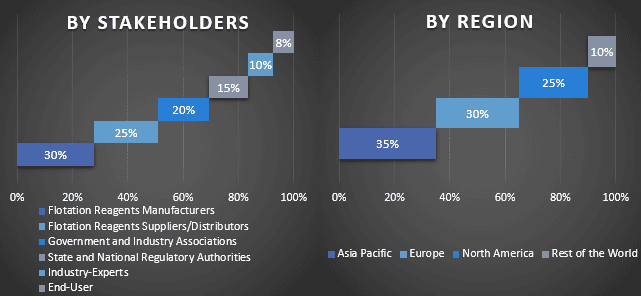
Ingegneria del mercato
La tecnica di triangolazione dei dati è stata impiegata per completare la stima complessiva del mercato e per arrivare a un numero statistico preciso per ogni segmento e sotto-segmento del mercato globale dei reagenti di flottazione. I dati sono stati suddivisi in diversi segmenti e sotto-segmenti dopo aver studiato vari parametri e tendenze nelle aree di vari tipi e applicazioni nel mercato globale dei reagenti di flottazione.
L'obiettivo principale dello studio di mercato globale dei reagenti di flottazione
Le attuali e future tendenze del mercato diverse dal mercato globale dei reagenti di flottazione sono state individuate nello studio. Gli investitori possono ottenere informazioni strategiche per basare la loro discrezionalità per gli investimenti sull'analisi qualitativa e quantitativa eseguita nello studio. Le attuali e future tendenze del mercato hanno determinato l'attrattiva complessiva del mercato a livello regionale, fornendo una piattaforma per i partecipanti industriali per sfruttare il mercato inesplorato per beneficiare di un vantaggio del first-mover. Altri obiettivi quantitativi degli studi includono:
- Analizzare le dimensioni attuali e previste del mercato dei reagenti di flottazione in termini di valore (USD). Inoltre, analizzare le dimensioni attuali e previste del mercato dei diversi segmenti e sotto-segmenti.
- I segmenti nello studio includono aree di tipo e applicazione.
- Definizione e analisi del quadro normativo per l'industria del mercato dei reagenti di flottazione.
- Analizzare la catena del valore coinvolta con la presenza di vari intermediari, insieme all'analisi dei comportamenti dei clienti e dei concorrenti del settore.
- Analizzare le dimensioni attuali e previste del mercato dei reagenti di flottazione per la regione principale.
- I principali paesi delle regioni studiate nel rapporto includono Asia Pacifico, Europa, Nord America e Resto del mondo.
- Profili aziendali del mercato dei reagenti di flottazione e le strategie di crescita adottate dagli operatori del mercato per sostenersi nel mercato in rapida crescita
- Analisi approfondita a livello regionale del settore
Correlati Report
I clienti che hanno acquistato questo articolo hanno acquistato anche

